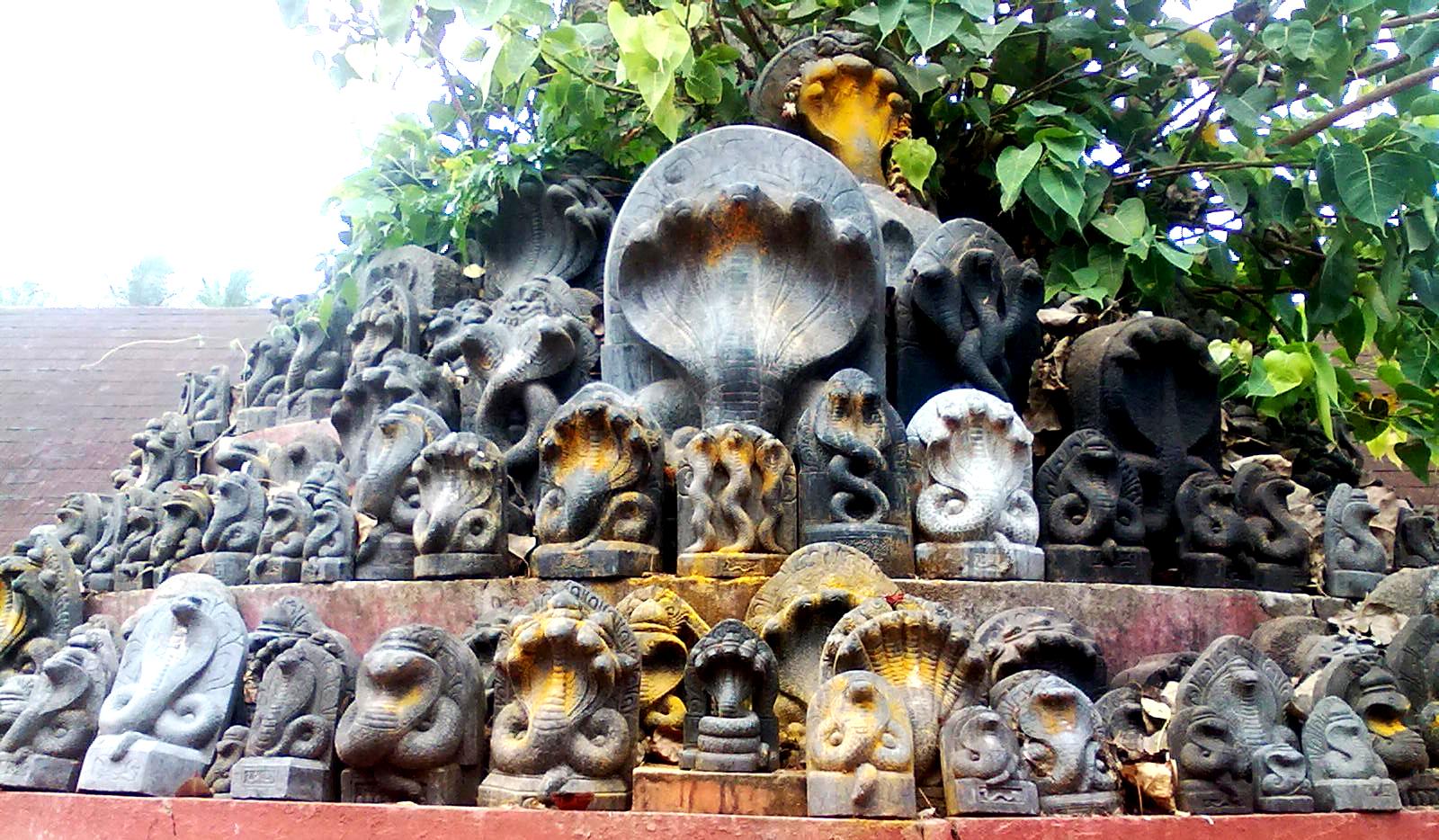Nagaradhane
Snakes, especially the cobra have been revered from ancient times all over India. Due to their mysterious appearances, slithering movements, snakes had always been held in awe in India. Snakes find mention in famous religious epics like Mahabharatha, Vishnu Purana etc. Hindu Gods like Vishnu, Shiva have been associated with snakes. According to Hindu mythology, Lord Vishnu takes rest under the shade of the giant snake, Adisesha. Lord Shiva wears a snake around his neck. It is difficult to trace the origin of Nagaradhane. Mostly, snakes were seen as a symbol of fertility. Elsewhere in India, snakes are wroshipped during the Nagarapanchmi Day. They are offered milk (Researches have shown that snakes are allergic to milk) and thilak is applied on their forehead.
But the snake worship ritual practised in Tulu Nadu are quite unique than the aforementioned rituals. Snakes have their own snake shrines in a corner of the garden, often under a neem tree known as Naga bana. This is usually a stone with snakes carved on it. Accordingly, nobody is allowed to chop the tree near the Naga bana. It is also believed that, snakes, specifically the cobras are not be harmed or killed by anyone. If harmed, the individual has to perform a ritual to cleanse the sin of killing/harming the snake. The belief is that the individual who refuses to perform the ritual will be cursed by the snake till eternity.
There are two distinct rituals performed in reverence to the snake. They are, Aashleshabali and Nagamandala. Of these, Nagamandala is more longer in duration and colourful than Aashleshabali. Nagamandala depicts the divine union of male and female snakes. It is generally performed by two priests. The first priest, called as patri inhales the areca flower and becomes the male snake. The second priest, called as Nagakannika or the female snake dances and sings around an elaborate serpent design drawn with natural colours on the sacred ground. The ritual is supplemented by playing an hour glass shaped instrument called as Dakke. The drawings in five different colours on the sacred ground are white (white mud), red (mix of lime powder and turmeric powder), green (green leaves powder), yellow (turmeric powder) and black (roasted and powdered paddy husk).
The ritual, centered around the serpent design, continues till early in the morning. A similar kind of ritual is found in Kerala and is known as Sarpam Tullal and Sarpam Kali.
Naga Banas
Nagabhanas or the sacred grooves are deemed to be the resting place of the Snake God. Cutting of trees, defacing the groove is considered as sacrilege. People are vary of the wrath unleashed by the deity. Naga banas have largely remained unspoilt and have contributed immensely to the preservation of valuable trees and medicinal plants.

Eight pre-eminent snakes from mythology:
Shesha, Adisesha or Seshnaga, whose name literally means ‘residue’, is believed to have been born of what was left after the universe and its inhabitants had been created. Revered as the king of the snakes, he has a 1,000 heads (‘sahasrashirsha’) which form a massive hood. He is believed to be Vishnu’s couch, and his hood shelters the god during the periodic deluges. Earth is said to rest on Seshnaga .He is believed to spew venomous fire that destroys all creation at the end of each kalpa, and is worshipped as a manifestation of Vishnu.
Ananta, literally ‘endless’, is a very long snake, encircling all earth and therefore symbolising eternity. Believed to be dark blue in colour, he, too, is regarded as a manifestation of Vishnu.
Vasuki, literally ‘of divine being’, is believed to be the green, seven-headed naga king who was used as a churning rope around Mount Mandara during the samudra manthan. He is of the same royal status as Shesha and Takshaka.
Manasadevi, the queen of the snakes, is sister to Vasuki. She is said to possess special powers to counteract snake venom and protects mortals from snakebite during Chaturmasya.
Takshaka, lord of the nagas, said to be saffron-coloured and have nine hoods. He was almost destroyed by King Janamejaya, a descendant of the Pandavas, but was saved in the nick of time by a young ascetic,
Astika, who was half Brahmin and half naga. This story is probably a mythification of Aryan-Dasa conflict and integration.
Kaliya, the five-headed demon serpent, who lived in the depths of the Yamuna, is believed to have troubled Krishna and his friends in their childhood. Finally, Krishna danced on his hood and subdued him, but spared his life at the behest of gopikas.
Padmaka or Padmanabha is the five-hooded, green-coloured snake who guards the south.
Kulika, of whom not much is known, is described as dusky brown, with a half-moon crescent on his head.
